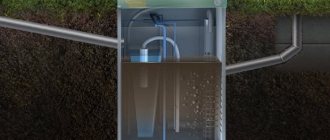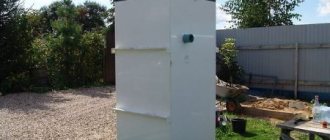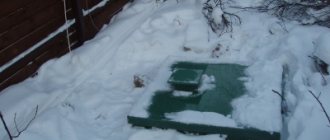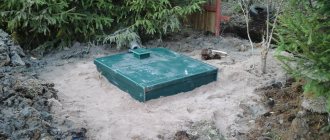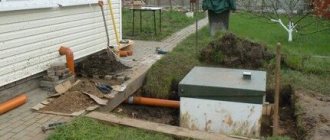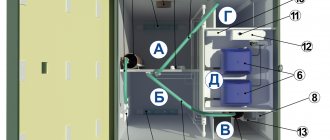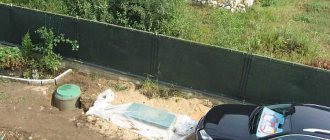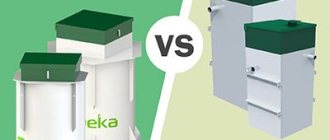How to properly preserve a Topas septic tank for the winter with your own hands
Preservation of the Topas septic tank for the winter includes a number of procedures:
The WWTP is disconnected from the power supply. Compressors and pumps are removed from the corresponding chambers. Clean the receiving chamber from non-recyclable particles. The sludge stabilizer is emptied using the built-in airlift. The contents of the tanks of the Topas septic tank are clarified according to the manufacturer’s instructions: 40% of the volume of one chamber is pumped out, filled with clean water, the process is repeated until the liquid is completely cleared.
Attention! It is not allowed to pump out liquid from all tanks at the same time. Violation of conservation rules threatens deformation or floating in the presence of groundwater.
Water clarification in the septic tank is carried out chamber by chamber, following the sequence: sludge stabilizer -› aeration tank -› receiver. After filling the WWTP, clean water in the aeration tank chamber should reach the following level:
- 35 cm from the upper edge of the interchamber partition of the aeration tank;
- 10 cm to the bottom edge of the inset of the supply pipe of the primary chamber, but not less than 10 cm to the bottom of the storage tank in the Topas septic tank with forced drainage of wastewater;
- 15 cm from the upper edge of the interchamber partition of the sump;
Individual elements of the device, including airlift pumps, are washed. The clean water outlet pipe on the septic tank is sealed with a forced-type clamp and a plug for the sludge pump. Individual station cells are equipped with pre-prepared 1.5-2 liter plastic bottles with sand. When submerged, the ballast must assume a vertical position. By tying the bottles by the neck, the pressure on the walls of the chambers from the freezing ice crust will be significantly reduced. The Topas septic tank is insulated from the outside with old, unnecessary things, polystyrene foam, and straw. The groundwater temperature is +4°C year-round, and the station’s water will maintain a similar regime.
Model description
The Topas-5 model is one of the most popular on the market.
A true classic of this type of structure, designed for processing domestic and industrial wastewater. The treatment facility is designed to serve a family of five. Such models are most often installed in cottages, private houses and dachas. The installation ensures complete sewage treatment. The water obtained as a result of purification can be used to water lawns and garden crops. The sludge collected in the settling tank is regularly pumped out and, after preliminary composting, is also used for household needs - it is an environmentally friendly fertilizer. Depending on the intensity of sewer use in a private home, the installation is cleaned once every three to four months.
Main technical characteristics:
- productivity up to one cubic meter of waste per day;
- work without adding reagents;
- year-round use possible;
- serving three to five people;
- simultaneous connection of one shower cabin, two sinks, toilet, washing machine is allowed;
- the installation can take up to 220 liters at a time (volley discharge when all plumbing fixtures in the house are working);
- the recommended depth for laying the sewer pipe is from 40 to 80 centimeters;
- sewage water from the house is drained by gravity;
- the weight of the installation is 230 kilograms;
- energy consumption for forced aeration is up to 1.5 kW per day.
Re-opening of the Topas septic tank
Preparing a septic tank for operation after winter storage requires a number of procedures:
- External inspection of the Topas cover for integrity and absence of visible damage.
- Comparison of the contents of the chambers with the level provided during conservation.
- Checking the liquid level in drainage wells and storage tanks.
- Filling the septic tank chambers with water to the operating level.
- Checking the condition of compressor filters.
- Supplying power, checking the functionality of the installed system.
- Compressor and pump installations.
- Checking the performance of float sensors for switching cycles of water treatment plants, alarm systems, air lifts, air lines;
- Testing of the drainage line from the Topas septic tank.
The ability of bacteria to self-heal will gradually return the septic tank to working condition after 2-3 weeks. Purchasing bacteria for septic tanks or adding spoiled fermented milk products to the receiver will help speed up the process of biomass reproduction after conservation.
General recommendations for use
Proper operation and regular maintenance of the Topas septic tank is the best way to avoid breakdowns and malfunctions of the device. To begin with, you should monitor the nature of the wastewater that enters the sewer system of the house.
For example, some cleaning substances that contain aggressive components can cause the death of microorganisms inside the septic tank. This also applies to substances such as gasoline, alkalis, acids, etc. These beneficial bacteria combine equally poorly with fungal cultures.
Therefore, it is better to choose another method for disposing of moldy products. All non-degradable waste, such as pieces of plastic, plastic bags, cling film, should also not be sent to an autonomous bacterial treatment station.
These products will not harm microorganisms, but they can cause serious blockage of the mechanisms and even their breakdown. To protect the septic tank from such contaminants, it is recommended to install special protective nets on all drains in the house. You should check the effluent level in your septic tank at least once a week to make sure the unit is not overfilled.
This check can be performed more often, especially after the septic tank is re-opened. Situations when there is no power supply for some reason deserve special attention. In such cases, the amount of waste entering the sewer system should be limited, since the likelihood of the tank overflowing is very high.
If the power supply is often absent or disconnected for a long period, it makes sense to take care of an alternative source of electrical energy. The condition of the coarse filters must be checked monthly. If the filter is damaged or excessively dirty, it must be replaced to reliably protect the system from blockages.
The septic tank is cleaned quarterly, i.e. every three months. This is a simple operation; you just need to pump out the sludge that has accumulated below from the septic tank tanks. This mass can be used on the site as fertilizer. It is recommended to empty the storage facility for waste that cannot be bacteriologically treated every six months or more often.
Compressors have a membrane that wears out over time. Don't wait until the compressor breaks down. Two years after putting the septic tank into operation, it is recommended to replace the membranes with new elements. Such scheduled repairs of compressors will have to be performed every two years.
The aerators that are equipped with the septic tank may also require replacement. The estimated service life of these elements varies from 12 to 15 years. The more often and more thoroughly the maintenance of the Topas septic tank is performed, the more stable its operation will be. If the situation has changed and the load on the sewer system has increased, this is a good reason to conduct an unscheduled inspection of the condition of the septic tank and clean it.
Important points of conservation
Theoretically, conservation of Topas is a fairly simple process to do with your own hands, however, in practice, beginners often make mistakes:
Complete drainage of the septic tank. The light weight of the station body threatens to float when the groundwater level rises in the spring, and the sewerage system will completely fail.
Improper insulation by sprinkling the lid with soil or sand; when snow melts and rains, bulk materials fall inside the system. In the spring, you have to re-clean the filters and septic tank chambers.
Failure to use ballast with sand increases the risk of destruction of the septic tank body. When water freezes in blocks, plastic bottles prevent critical deformation of the body.
Principle of operation
The Tver septic tank combines all three possible wastewater treatment technologies. In the first - receiving - compartment, mechanical cleaning occurs, as is customary with classic septic tanks. In the other two there is aeration and processing of wastewater by aerobic microorganisms, like in aeration units (AU) and in two - processing by anaerobic microorganisms (without oxygen), and at the outlet there is a biofilter that completes the purification. This is such a complex system, but according to the manufacturers, the output comes out with water that is 98% purified and can be discharged directly onto the ground or discharged into a reservoir.
Septic tank Tver from the inside
The Tver septic tank differs from other installations for autonomous sewerage in its horizontal layout - sequentially located compartments in which water overflows. Its device can be seen in the photo below.
Septic tank installation Tver
The cleaning procedure is as follows:
Not to say that the process is simple, there are many nuances, but the cleaning result is not bad and the installation does not require daily attention and works reliably.
How to do without conservation
If you plan to use the Topas septic tank 2-3 times a month, it is not necessary to preserve the system. Working compressors will ensure the flow of processes that support the vital activity of bacteria. The operating costs of the device correspond to the level of energy consumed.
Pay attention! The Topas system does not freeze, thanks to maintaining a temperature of 10-11 degrees in the workstation.
The condition is achieved by a number of features:
- Using high quality polypropylene foam.
- Compression of air, accompanied by the release of heat.
- The process of biological oxidation of bacteria.
What does emptying the septic tank lead to in winter?
The results are quite unpleasant:
1. In the spring, when groundwater rises, you can find an empty treatment plant floating on the surface.
Despite the presence of stops on the sides, the empty station weighs little and is therefore not able to resist the influence of groundwater. They exert lateral and vertical pressure on the treatment station, which is easily pushed to the surface.
Keep in mind that during a shutdown, water cannot be drained from the septic tanks from the chambers.
It should be remembered that in addition to the septic tank, the pool should also be prepared for wintering. The article discusses several simple tips that will help you properly preserve your pool for the winter. If you have a drainage pit installed on your property instead of a septic tank, then it should also be insulated from above to avoid freezing.
2. The soil in which the treatment plant is located is mobile. It can be driven by changes in temperature and groundwater levels. As a result, the plastic container is subjected to great physical stress. Despite its strength, plastic cannot withstand pressure and may crack or change shape. As a result, you will have to remove the treatment station and replace the faulty installation with a new one.
Return to content
Answers on questions
How much does it cost to preserve a Topas septic tank?
Conservation of the Topas septic tank by third-party companies will cost at least 4,000 rubles. Wanting to save money, many owners of small-sized models carry out septic tank maintenance themselves. The process will take 3-4 hours.
Can groundwater push Topas out of the ground?
No. The side supports of the housing prevent the system from being pushed out of the pit. The structure is also filled with water after conservation, adding weight to the product.
Can bacteria die without food?
Yes, if the septic tank is not used in winter, the bacteria inside die. Preserving the installation or periodically adding fermented milk products to the receiving chamber will help solve the problem.
The RCD in the house is turned off
An RCD is a residual current device controlled by differential (residual) current. In Russian - RCD - a fire prevention mechanism that protects a person from electric shock in the circuit where it is installed.
Over the years of our company's work, we have encountered cases where, for unknown reasons, the RCD located in the electrical panel turns off in a house. Having spent a long time figuring out why this is happening, we came to the conclusion that the RCD turns off due to the occurrence of a leakage current inside the septic tank. Since there is 100 percent humidity inside the septic tank, an aggressive environment, add to this the leakage of sockets and the control unit = the likelihood of such a situation occurring is by no means zero.
Solution We recommend calling an electrician and upgrading the electrical panel so that the septic tank is connected to the circuit breaker bypassing the RCD.

